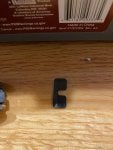When you went to install an arrow, was it hard to install? Normally the arrow should be easy to install and easy to remove if the brush holder is functioning properly. The brush should easily retract 1/16 of an inch. Looking at the brush from the side there should be a space between the bottom of the brush and the top of the rail-stock.
I will give the instructions as if the scope was still mounted, some of which you may have already done. If you are not sure, make notes and take pictures.
1)remove the scope making a notation what slots the cross bolts were in.
2)at the back of the housing that the picatinny rail fastens to, remove the allen head bolt.
3)remove the two counter sunk screws that hold the picatinny rail to the housing as these fasten the housing to the top of the trigger box.
4)remove the picatinny rail and housing as a unit.
5)flip the picatinny rail-housing over and remove the screw behind the brush.
6)put your thumb on the brush and press it to see if you can feel upward movement. If you can the brush is functioning properly. If not the brush holder may have been installed 1/2 way around.
7)with the brush facing upward you will notice that small section curves down ward, toward the picatinny rail. At the front of this small section is a groove. Insert a flat screw driver and while carefully pushing it in, push the brush holder assembly forward. The screw driver unlocks this small section (brush holder assembly).
8)with the brush holder assembly removed, you will see another small screw going up through the main housing into the picatinny rail. Remove this screw and the picatinny rail will come off. This is where you put the required shim with that screw going up through it. The screw holds the shim in place. Depending on the thickness of the shim, a longer screw may be required. If so make sure it does not stick above the top of the picatinny rail.
9)leave the brush holder out for now until you get the proper shim thickness as the housing and picatinny rail may have to be re installed a few times.
10)when you remove the brush, you will see a flat curved spring with a hook on one end. As the brush is retracted when an arrow is loaded, this spring flattens out a bit. After the arrow is shot the spring pushes the brush back down to its normal position.
11)the brush holder only fits one way in the housing as there is a small groove for a projection to fit into. If the brush holder was installed that 1/2 turn out or not seated properly, the brush will not retract properly.
12)just reassemble everything.
Note: do not cut the brush.
Here are some pictures showing where to put the screw driver and the flat curved spring in the brush holder.
![]()
![]()
![]()
I took my 2018 Barnett Drop Tine STR a part so I could give you these instruction. I had a Barnett Whitetail Hunter Pro STR that had the same problem.
All the best.












